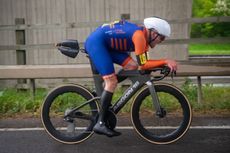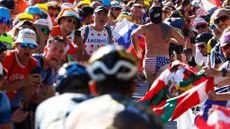Clinchers, tubulars and tubeless - which tyre system is the fastest? (video)
As road cyclists we have three different wheel tyre systems available - Clinchers, tubular and tubeless. We performed some experiments to determine which has the lowest rolling resistance and is fastest.

Traditionally, cyclists often assume that tubular tyres are the fastest, as they are still the choice of most professional riders.
However, recently many teams such as Katusha, Quick-Step and Cannondale have been spotted using clinchers or tubeless tyre set ups in time trials. Tony Martin even won the World Championship time trial on clinchers!
We wanted to try and find out which of the three tyre systems has the lowest rolling resistance and is consequently the fastest.
>>> Can a tubeless tyre survive a nail? (video)
To do this our experiment has two parts. Firstly we are going to ride the tyres on rollers at a set cadence, in a set gear, and record the power output and wheel speed achieved.
The second test involved riding around the velodrome in a bid to get an idea for the rolling resistance in some more real world conditions, on a more realistic road surface.
On the rollers, the tyres were ridden at around 250-300W for 5 mins, to allow them to warm up.
Once stabilised they are ridden for 5 more minutes at 300W as test run. Around the track, the tyres were ridden at roughly 300W for around 15 minutes. This duration gave plenty of time for plenty of data, from which a snapshot could be obtained.
To minimise variables, we used the same profile wheel in both tests – DT Swiss RC65 Dicuts in both the tubeless clincher and tubular versions. We also used Vittoria tyres throughout the test.
Power measurement was recorded using calibrated Power Tap P1 pedals.
The tubular Vittoria Corsa G+ has latex inner tubes, so for consistency, we used latex tubes with the clinchers too.
For all the runs, tyre pressure was 100psi and the complete system weight was recorded prior to each run. The fit. files from the rides were processed and correction factors were applied to calculate the coefficients of rolling resistance for each tyre on a flat surface.
This was done for each power and speed value at 1 second intervals and then averaged over five minutes.
Results
The tubulars' coefficent of rolling resistance (Crr) was 0.0029.87, which equates to 30 watts of rolling resistance at 40kph for an 87kg system weight.
The clinchers' coefficient of rolling was 0.002852. Interestingly this is slightly lower than the tubular and equates to 28 watts of rolling resistance at 40 kph.
The tubeless tyres' coefficent was 0.00265. This equates to 25 watts of rolling resistance at 40 kph for an 87kg rider plus bike. A surprising result perhaps, but the tubeless tyres were by far the fastest and this was consistent in both the velodrome and roller tests.
>>> How to puncture proof your tubular and clincher tyres (video)
Why is tubeless the fastest? Having spoken to engineers, the explanation is to do with friction.
In a tubular system there is friction in the glue layer and between the tyre tread and inner tube. In a clincher you don’t have the glue layer, but you still have the friction of the inner tube.
A tubeless system removes the tube and a large chunk of the friction in the process.
Some tubeless tyres have a thicker carcass, which can be slower, however the Vittoria Corsa Speed has just 1.7mm thickness compared with 2.4mm for the Vittoria Corsa G+.
This is less of a problem as the sealant can prevent flats.

Thank you for reading 20 articles this month* Join now for unlimited access
Enjoy your first month for just £1 / $1 / €1
*Read 5 free articles per month without a subscription

Join now for unlimited access
Try first month for just £1 / $1 / €1
Get The Leadout Newsletter
The latest race content, interviews, features, reviews and expert buying guides, direct to your inbox!
Oliver Bridgewood - no, Doctor Oliver Bridgewood - is a PhD Chemist who discovered a love of cycling. He enjoys racing time trials, hill climbs, road races and criteriums. During his time at Cycling Weekly, he worked predominantly within the tech team, also utilising his science background to produce insightful fitness articles, before moving to an entirely video-focused role heading up the Cycling Weekly YouTube channel, where his feature-length documentary 'Project 49' was his crowning glory.
-
 Drama at UK road bike time trial champs as protest launched against provisional winner
Drama at UK road bike time trial champs as protest launched against provisional winnerRiders wait for results as Cycling Time Trials investigates alleged rule infringement
By James Shrubsall Published
-
 I'm on my way to being one of cycling's superfans - I've got the t-shirt, but have yet to lose my trousers
I'm on my way to being one of cycling's superfans - I've got the t-shirt, but have yet to lose my trousersHaving unearthed the 'love supreme' of cycling's superfan clubs, Adam Jones has tasked himself with entering the inner circle, he just can't decide which to infiltrate
By Adam Jones Published